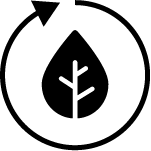Climate action projects
Environmental investments
of the electrical energy comes from renewable sources

We aim to be carbon neutral by 2050 through the implementation of new and innovative technologies that contribute to mitigating and adapting to the effects of climate change. These actions are focused on achieving the migration to alternative energies and sustainable materials, and carbon capture and/or offsetting.

We responsibly manage the ecosystems where we operate. Our main projects include the Amancay Sanctuary, the first private conservation area in Metropolitan Lima, and the inclusion of Celepsa in the Board of Trustees of the Nor Yauyos Cochas landscape reserve.

We continue to regulate the percentage of our waste and recycled/reused materials from construction, cement and energy, to contribute to the mitigation of natural resource use. We also integrate co-processing through the use and creation of alternative fuels.
The goal of the global cement industry is to achieve carbon neutrality by 2050.
Grupo UNACEM aims to achieve net emissions of 500 kg CO₂-eq/t of cement by 2030.


UNACEM Peru promotes the preservation and research of the species of the ecosystem of the hills and the development of activities for local populations. Among its main milestones is the conservation of the Amancaes flower and the sustainable care of the area in which it is located.


Our cement business units in Peru and Ecuador made the most significant progress in reducing the use of clinker, with a clinker-cement factor of 85% and 70%, respectively.



Our ready-mix concrete company in Peru received this certification that supports the sustainable management of its production processes.


UNACEM Ecuador has managed to reduce its water consumption by 43.64%. In addition, as of 2022, the percentage of recycled/recirculated water was 68% of a total freshwater withdrawal of 471,694,000 m³.



